|
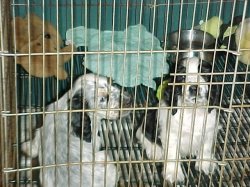
'Johhny & Michael' -
Land
|
Your puppy will need a
place of his own. Some people think using a crate or cage is cruel, but
it's quite the contrary. Why? A cave was home to the dog's wolf-like
ancestors, so your puppy instinctively feels cozy and safe in anything even remotely cave-like.
It also serves the same purpose as child's playpen does for the
child. It keeps him out of trouble when he's unsupervised. |
| The
crate is probably the most important purchase you can make for your
new puppy. They come in wire and fiberglass, the choice being a
personal one. Many of the wire crates fold down like a brief case for
ease in transporting and storing, and allow for more airflow and
visibility for the puppy. Some prefer the enclosed fiberglass crates
for more den-like privacy. However, a wire crate can be easily covered
with a large towel. Crates can be ordered through wholesale catalogs
at a much more reasonable price than in retail stores.
Another plus to having your pup/dog in a
crate at night is the fact that you will always know exactly where
your dog is in case of an emergency. In most house fires, for
instance, loose dogs will stay where they know best and they will
hide. You can keep a show or slip-lead (no collar required)
looped through each crate so, the event of an emergency
leave-taking, your dog will be easy to locate and safely with
you.
Use care when choosing a wire crate for your puppy.
Make sure the wire mesh is small enough that you puppy can't get his head
or paw stuck. Avoid crates or pens that have sharp exposed edges that could
injure your puppy.
|
| Make sure you choose a
crate that's large enough for your pet when he's an adult. (Most cocker people
choose either a #200 or #300 size airline kennel or its equivalent). If the crate seems
too large and overwhelming while he's a baby, put a cardboard box turned
onto its side at the back of the crate with a fluffy blankie
inside.
The crate should be your puppy's bed,
feeding place, travel case, refuge when things get tough for the
puppy, and (most important) a safe place for the puppy when no one is
able to watch it and keep it out of mischief. |
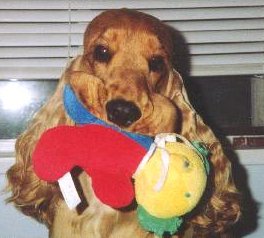
'Champ' - Owczarzak |
|
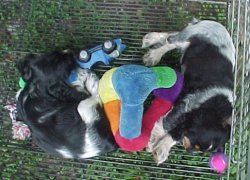
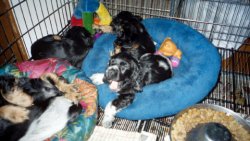
Raven's Litter - Minor
|
Your puppy should sleep in the crate at
night at least until it is reliably housebroken. If its final sleeping
place is to be in a room with you, then the crate can be placed next
to the bed at night. If it will always be sleeping in another room,
the crate should remain a permanent fixture in his sleeping room. The
puppy may make a terrible fuss the first few nights, but if you set
the rules in the beginning, you will have a very well adjusted pup in
no time.
Put your puppy out just before bedtime and
make sure the crate is warm and dry (never put water in the crate) and
then do not give in to protests, no matter how loud they may get! If
your pup is between 8-10 weeks when you bring it home, a 2am potty
trip may be
|
|
necessary, but only if the puppy has been sleeping for at
least a few hours. Take outside right away if your puppy wakes up and
starts to cry-s/he is trying to tell you something.
No playing, just
right to the business at hand, then praise and put pup back in the
crate till morning. Your puppy will try very hard not to soil its
sleeping area, that's why it cries. A young puppy however, cannot wait
for you to "sleep in" in the morning. The trip outside MUST
be top priority in the AM. Usually the middle of the night trips only
last a week or so, and are usually only necessary with puppies
under 12 weeks of age.
|
|
Housebreaking
is made very simple with the use of the crate. When the puppy gets up
in the morning, carry it to the door or to the spot that it
should use to relieve itself. A few minutes after feeding it should be
taken out again. After the puppy has relieved itself it can come back
inside. Young puppies need to go very often, and always after eating,
napping or playing. Timing means everything! NEVER rub a puppy's nose
in its own mess and do not hit a puppy for making a mistake. It is
much more effective if you immediately grab the puppy (assuming you caught
it in the act) by the scruff and say NO in
a very loud, upset voice and put it quickly outside. The shock is all
that is necessary and the puppy does not feel that it is being
abused.
|

Logan & friend - Cook
|
|
Don't leave the puppy confined for long
periods of time, and don't banish him to his place when he's been bad. Doing
that will convince him that it's a place of punishment rather than a comforting
refuge. Always give the puppy a safe toy to play with and chew while he's
in his crate, to keep him from being bored. Bored puppies quickly become
noisy puppies.
|
|
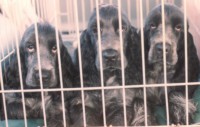
Audi, Cooper, & Mercedes - Land
|
Do not leave the
puppy loose in the house or locked in a room unattended until you are
absolutely sure it is out of the chewing stage. English Cockers can be
chewers long past the usual puppy stage!! S/he may chew your favorite
chair, shoes, or an electrical cord. A young puppy will always chew
everything and it must learn to chew only its own things.
|
|
I do lightly tap a
puppy under the chin when it is chewing a forbidden object, especially
as it gets older. With a very young puppy, usually the best method is
to say NO and substitute one of its own toys.
Excessive use of the crate is a bad idea.
If a puppy is left in its crate too much you will not have a
well-adjusted companion. When someone is around to watch, it should be
part of the family and it is best if the crate itself is in a place
where there is activity. The puppy should not be left alone in a dark
place, crated, for hours on end. |
|
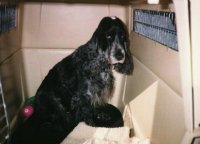
'Chelsea' - Smith |
As the puppy gets older,
the crate will become his own room, his part of the house. Respect your
dog's privacy when he's in his special place. Don't let children
bother or tease him, or pull him out to play especially when he's eating
or sleeping. He needs to feel that he's safe when he's in "his
room."
|